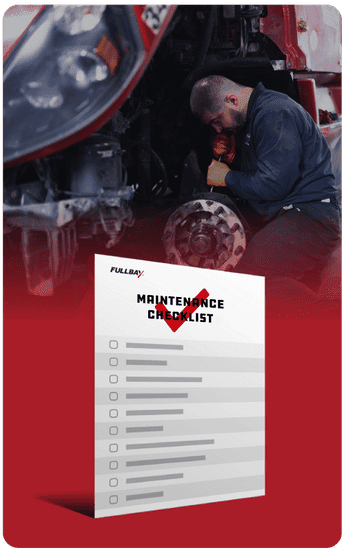Heavy Equipment Maintenance Checklist

Maintenance is a critical part of vehicle upkeep—we’re preaching to the choir here, but you know what? It doesn’t hurt to repeat it at times. Heavy-duty equipment and trucks form the backbone of commerce…and they’re also everywhere. They share the roads with us; if one breaks down, or has trouble, that’s not just a kink in the commerce line—it’s a danger to those in the next lane.
That’s where preventive maintenance comes in. Also called “PMs” or “PM work,” preventive maintenance involves routine—often scheduled—checks and inspections of vehicles. It can encompass replacing parts at a certain mileage, or just making sure wear and tear are appropriate for how long a vehicle has been in action.
PMs are a critical part of keeping a vehicle whole and functioning because they allow you to catch problems before they start. At Fullbay, we’ve even compared PMs to yearly checkups with your doctor to ensure you are in good shape.
WHAT SHOULD YOU LOOK FOR?
Inspections should definitely include careful scrutiny of electrical components, lighting, DEF tanks, brakes, and the hydraulic system—and that’s just a start. There are 53+ things we generally recommend checking during a maintenance inspection.
That’s why we’ve created this checklist. When you’ve got everything laid out in front of you, it’s way, way harder to miss a step.
MAINTENANCE CHECKLIST
If you use Fullbay, you know you can build your own maintenance checklist within the app that you can then mark off on your phone, tablet, or laptop as you conduct your inspection. Still, there may be some benefit to having a paper version of your list handy. Some customers will actually require you to use paper, presumably so they have a physical record they can keep with their documentation.

Better safe than sorry, right? If you or your customers are still using paper, this heavy-duty maintenance checklist will come in handy. You can download it, print it out, and make copies of it. Hand it out to your techs and make sure they’re checking off sections and components as they go.
WHY SHOULD YOU TRACK MAINTENANCE RECORDS ELECTRONICALLY?
We can agree that paper serves its purpose, especially when you’re dealing with fleets that are maybe not quite ready for the twenty-first century. But we are in the twenty-first century and the benefits of an electronic checklist are significant. We’re pretty proud of the electronic checklists from Fullbay, which make the job go by faster and result in a safer vehicle.
Here’s some of the perks:
- When you use electronic checklists from Fullbay, you’re legally able to verify a truck is in working order and has a valid BIT or DOT.
- Fullbay displays a trail for fleets that indicates whether a truck failed a DOT inspection—it will also highlight what corrections are necessary to fix the truck. Once the truck is repaired, the list will update, indicating the vehicle is compliant again. Guys, we can’t stress this enough—a well-maintained truck is a safe truck.
- Fullbay lets you customize your checklists. Not every shop deals with the same kind of repair; if braking systems are your bread and butter, for example, you can create a hyper-specialized checklist centered around braking and related operations.
Intrigued by the idea of digital checklists? Ready to contribute to safer roads? Try out our demo! Our checklists are pretty awesome, but they’re just scratching on the surface of what Fullbay can do for your shop.

